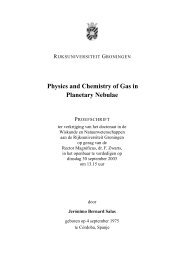TRACING ABUNDANCES IN GALAXIES WITH THE SPITZER ...
TRACING ABUNDANCES IN GALAXIES WITH THE SPITZER ...
TRACING ABUNDANCES IN GALAXIES WITH THE SPITZER ...
You also want an ePaper? Increase the reach of your titles
YUMPU automatically turns print PDFs into web optimized ePapers that Google loves.
is a spherical nebula with a low mass (� 3 M⊙) progenitor star (Pottasch et al.,<br />
2004). IC 2165 probably experienced third dredge-up (in addition to first dredge-<br />
up) because it has C/O ∼ 2 (Pottasch et al., 2004). The elements not much affected<br />
by the various dredge-up episodes (Ar, Ne, S, and O) all have subsolar values in<br />
IC 2448 and IC 2165, which implies that the progenitor stars of these nebula were<br />
created from metal deficient gas.<br />
The IR continuum of IC 2448 gives a cool dust temperature of ∼ 100 K, support-<br />
ing previous studies that show IC 2448 to be an old, evolved nebula. Additionally,<br />
IR lines that would come from the photodissociation region such as [Ar II] and<br />
[Si II] are not observed. Perhaps this indicates that most of the photodissociation<br />
region has been destroyed, which fits the picture of IC 2448 being an old PN where<br />
the ionization front has gobbled up most of the photodissociation region.<br />
2.7 Conclusions<br />
This is the first mid-IR spectral study of IC 2448. The abundance of helium is<br />
slightly above solar, indicating that some chemical enrichment has occurred. The<br />
high uncertainties in the nitrogen and carbon abundances (due to their reliance<br />
on abundances determined from UV lines which depend strongly on the electron<br />
temperature and to a lesser extent on the extinction) make it difficult to determine<br />
how much chemical enrichment occurred. The elements not affected much by stellar<br />
evolution (Ar, Ne, S, and O) all have subsolar values in IC 2448, indicating that<br />
the progenitor star formed out of somewhat metal deficient material. Our use of<br />
infrared ionic lines which are less sensitive to extinction and temperature, and some<br />
of which arise from ions with no observable lines in the optical or UV, leads to a<br />
more accurate determination of abundances for Ar, Ne, S, and O than previously<br />
possible. The abundances determined fit with the picture of IC 2448 having a low<br />
50













